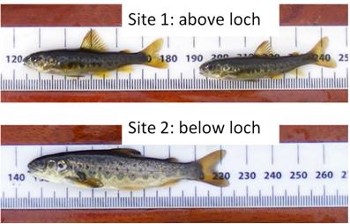Of big fry and small fry . . .
Posted: Tuesday 3 September, 2013 @ 16:54:02

I was recently asked ‘how big are your salmon fry this year’?
The person who asked said that where he’d been surveying juvenile salmon populations (elsewhere in Scotland in 2013), salmon fry were smaller this year. ‘Had I observed the same thing?’ Another person was surprised by how big the wild salmon fry that we recorded in July above the falls in the Bruachaig River (River Ewe system) were, the first ‘wild spawned’ juvenile salmon we had seen above the falls since the 1990s.
Here’s a short story about fry size. For the illustrated report please click here.
Following a record number of grilse entering the upstream trap at the mouth of the little Tournaig river in 2012 (and subsequently released to continue upstream), this summer (2013) we recorded our highest average Catch per Unit Effort [CPUE] number for salmon fry for our six electro-fishing sites in the principle spawning stream, the Allt na Coille, since 2003 demonstrating successful spawning of salmon in 2012 and a large population of salmon fry in the system. That’s exciting, as the juvenile salmon population in 2012 was at a very low level following several years of limited spawning.
Our story is about the sizes of the salmon and trout fry that we caught at two Tournaig electro-fishing sites surveyed on the 26th August 2013. Site 1 is at the vehicle ford between the grassy fields in the Allt na Coille above Loch nan Dailthean; Site 2 is just below the main road, below Loch nan Dailthean.
At Site 1, above the loch, we fished for 6 minutes, covering a wetted area of stream bed of approximately 90m2. Altogether we caught 48 salmon fry, 6 salmon parr, 6 trout fry and 4 minnows. The CPUE was very high at 8 salmon fry per minute. However salmon fry were relatively small here at between 39mm and 55mm in length, with an average length of 45.75mm.
At Site 2, below the loch, we fished for 6 minutes, covering a wetted area of stream bed of approximately 90m2. Altogether we caught 25 salmon fry, 21 trout fry, 3 larger trout, 6 minnows, 6 eels and a stickleback. The CPUE for both salmon fry and trout fry was also high compared to averages for Wester Ross at over two fish per minute. Salmon fry were much bigger than those in the stream above the loch at between 58mm and 77mm in length, with an average length of 67.7mm.
Why were the fry so much larger at the site below the loch?
At least four factors may have contributed to the recorded differences in fry sizes at the two electro-fishing sites:
-
Water temperature: at site 1 the temperature was recorded at 16.8C; at site 2 it was recorded at 18.3C. Juvenile salmon would be expected to grow faster at higher water temperatures. Loch nan Dailthean is a shallow loch and during periods of sunny weather during the summer can warm up quickly. Also, perhaps fry hatched earlier below the loch.
-
Stream and flow stability: at both sites the streambed was recorded as ‘stable’; however, at site 2 below the loch the weed beds indicated particularly high stability of the streambed. Loch nan Dailthean acts as a settlement pond for sediment carried downstream during big spates, and the site below the loch may retain a relatively higher flow during periods without rainfall.
-
Fish densities: the density of salmon fry at site 2 below the loch was lower than at site 1 above the loch. However, when trout, eels and minnows are also taken into consideration, the overall number of fish is not so different from above the loch; and the total biomass of fish per unit area, probably higher (to calculate . . . ).
-
Food supply and stream fertility: this may be the primary reason for the faster growth of salmon fry below the loch. In previous years, we’ve also recorded unusually large salmon fry at the top of the Little Gruinard below the outflow from the Fionn Loch, and in the nearby Allt Beith, in the outflow below Loch Bad na Luacharaich (locally known as the ‘Goose Loch’). Loch outflows can provide a steady supply of small insect larvae and zooplankton, more food for small fish than in streams above lochs. At Tournaig, nutrient levels are also likely to be higher at site 2 than at site 1, with septic tank effluents entering the stream below the loch.
This example at Tournaig illustrates how the growth of juvenile salmon can vary considerably within Wester Ross, according to many factors.
Thank you to Tournaig estate for permission to learn about fish at Tournaig and to Marine Harvest for support.
For more information, please contact Peter Cunningham at info@wrft.org.uk or Ben Rushbrooke at ben@gcnursery.co.uk .